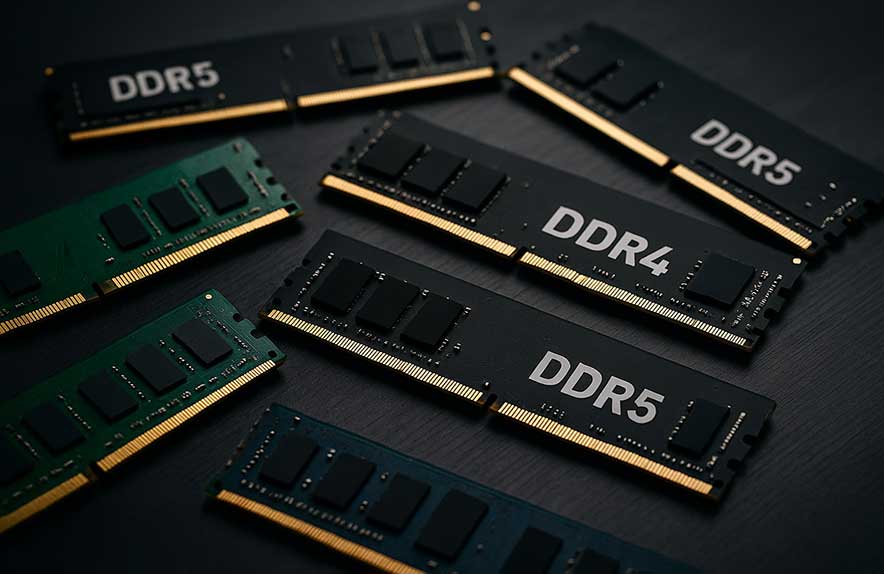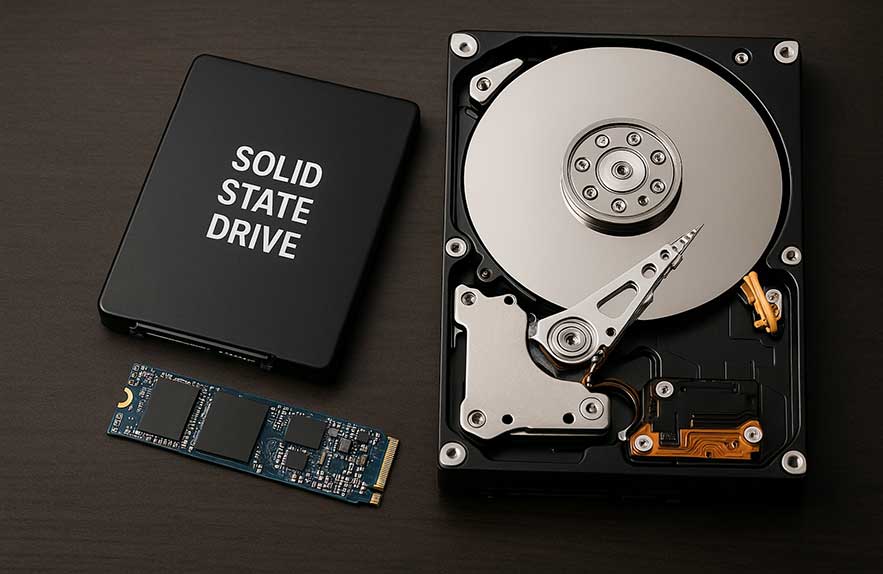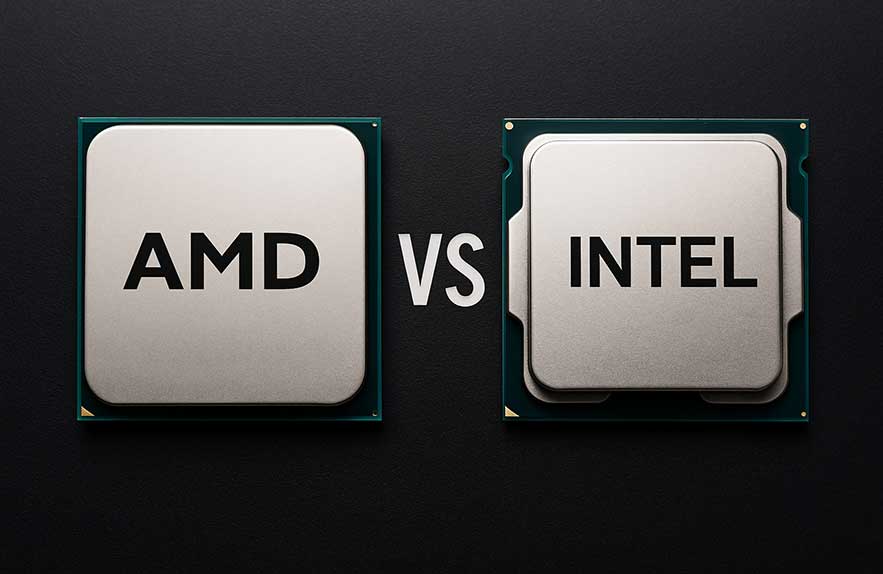
DDR4 vs DDR5 RAM: Why the Upgrade Matters
The ddr4 vs ddr5 debate has become a centerpiece in every conversation about upgrading PCs in 2025. As computers power through bigger games, tackle creative work, and support dozens of open tabs and background apps, having the right RAM is more critical than ever. When people discuss ddr4 vs ddr5, they are asking if the leap to newer memory actually speeds things up, makes multitasking smoother, or simply future-proofs your next desktop or laptop purchase. Understanding these differences can save you money and keep your computer feeling fresh for years to come.
RAM, or Random Access Memory, is where your computer stores data it needs to access quickly. If you use your PC for gaming, video editing, music production, or even just lots of web browsing, the speed and quality of your RAM directly shape how snappy your apps feel. In the danamic world of technology, the ddr4 vs ddr5 ram comparison is not just about speed it’s about real improvements in efficiency, stability, and the ability to upgrade as software grows more demanding.
Until recently, ddr4 was the standard in nearly every new machine. It offered big improvements over older memory types and could be found in everything from student laptops to serious gaming rigs. But hardware never stands still. DDR5, the new kid on the block, is making waves thanks to its promise of faster data rates, bigger capacities, and smarter power management. With every major processor and motherboard brand rolling out support for ddr5, shoppers everywhere want to know if the switch actually matters or if it is just another marketing buzzword.
This comparison between ddr4 vs ddr5 is essential for anyone planning a new build or a major upgrade. Gamers want higher and more stable frame rates for smooth play. Office workers hope to keep dozens of programs open without slowdown. Content creators expect faster video rendering and fewer crashes when working on large projects. All these demands add up, and choosing the right RAM is one of the most cost-effective upgrades you can make to your PC today.
If you have ever tried to open too many browser tabs and seen your computer crawl, or struggled with longer than normal boot times, RAM is nearly always a factor. Now, with ddr5 stepping into the mainstream, the ddr4 vs ddr5 ram debate matters for both budget-conscious users and those who want the absolute best speed possible. For a user-friendly introduction to how the new generation of RAM can impact your daily experience, check out Crucial’s DDR4 vs DDR5 overview.
In the next section, we will get specific about what has changed between ddr4 and ddr5, and how those updates actually make a difference for speed and multitasking in real life.
Table of Contents
- DDR4 vs DDR5 RAM: Why the Upgrade Matters
- Speed and Performance: What Changed Between DDR4 and DDR5?
- Capacity and Efficiency: How DDR5 Moves Ahead
- Compatibility: Can You Simply Upgrade to DDR5?
- Price and Value: Is DDR5 Worth It Yet?
- Final Verdict: Should You Upgrade to DDR5 RAM Now?
Speed and Performance: What Changed Between DDR4 and DDR5?
When people compare ddr5 vs ddr4, speed and performance are often the main thing on their minds. Upgrading RAM is all about getting a smoother experience, whether you play games, edit video, or just want your computer to keep up with your multitasking. The leap from ddr4 to ddr5 has brought some real changes you can feel, and understanding the actual numbers helps beginners and upgraders avoid confusion.
DDR4 has been around for many years and set the gold standard for reliable, everyday memory. Most DDR4 sticks run at speeds between 2133 and 3200 megahertz (MHz), which is fast enough for common office work, web browsing, and even most games. Some higher-end ddr4 vs ddr5 ram kits pushed a bit higher, but they required careful setup and compatible motherboards. For most users, DDR4 made basic computing and moderate multitasking easy, which is why it remains in so many systems today.
With the arrival of DDR5, the big story is speed. DDR5 modules start at a floor of 4800 MHz and quickly scale up above 6000 MHz on enthusiast motherboards. This higher bandwidth gives your computer the ability to move much more data in the same amount of time, which benefits apps that need lots of memory to operate smoothly. The jump in ddr5 ram speed is not just theoretical. In real life, users see faster loading screens in games, snappier response in creative programs, and better system stability when lots of tasks are running together.
DDR5’s improvements in burst handling mean your PC is less likely to stutter or freeze when opening big files or launching new apps while other programs are still working in the background.
Another huge upgrade in ddr5 ram vs ddr4 ram is the way memory handles multitasking. DDR5’s design lets it serve more requests at once, which is especially noticeable in computers with more powerful multi-core processors. If you edit videos while running other software, or play modern games that use more RAM, the switch from ddr4 to ddr5 can keep your computer feeling fast even under heavy load.
It is important, though, to match your RAM choice to your system. Motherboards and CPUs must support ddr5 speeds to unlock the full benefit. If you run DDR5 at lower speeds than your chip allows, you are missing out on extra performance. To get an updated sense of how ddr5 vs ddr4 stacks up in real games and apps, check out the side-by-side charts on Tom’s Hardware DDR5 vs DDR4 guide with real-world test results.
To sum up, ddr4 vs ddr5 ram upgrades mean higher speed, better handling of multitasking, and a smoother experience as software grows more demanding. Next, we will explore how these RAM generations differ in capacity and efficiency critical for everyone choosing memory in a laptop, gaming rig, or creative workstation right now.
Capacity and Efficiency: How DDR5 Moves Ahead
When making a ddr4 vs ddr5 decision, many buyers focus on the raw speed numbers at first. But there is more to this upgrade than just how fast your computer retrieves data. DDR5 brings two major advantages beyond headline ddr5 ram speed: bigger memory capacity per module and smarter use of energy. Both of these updates offer real-world benefits, especially as users ask more of their computers at home, in the office, or on the road.
First, let’s talk about how much RAM you can actually get from each technology. DDR4 vs ddr5 ram modules top out in different places. DDR4 sticks, still common in most PCs, usually max out at 16 GB or 32 GB per module, with workstation-grade desktops sometimes using 64 GB. DDR5 turns that up a notch. Typical desktop DDR5 modules now come in 16 GB, 32 GB, and even 64 GB sizes, and high-end builds go well beyond.
For creative professionals, researchers, or anyone handling huge datasets, that jump is a real game changer. In laptops, DDR5’s higher density means that thin and light devices can now come standard with 32 GB or more without needing custom solutions or sacrificing battery life.
Efficiency is another key win for DDR5. DDR5 runs at a lower voltage than DDR4, meaning your memory pulls less power from the system overall. This matters especially for laptops, all-in-ones, and mini-PCs where battery life and staying cool are more important than ever. Even for desktops, less energy usage translates to less heat and a quieter fan system. The way DDR5 modules manage internal communication also boosts reliability helping keep performance high even under long working sessions or heavy gaming loads.
In practical terms, this means that anyone using lots of browser tabs, editing large media, or running several apps at once will hit fewer slowdowns with DDR5. The combination of high ddr5 ram speed and bigger module size removes the old limits on multitasking or heavy research tasks. Gamers may not need huge capacity, but professional users and future-proof builds will see a benefit every day.
DDR4 vs DDR5 is not just about headline MHz numbers it’s about real results across laptops and desktops. If you want graphs and real-of-world benchmarks for memory efficiency and capacity, AnandTech’s DDR5 vs DDR4 article covers what the differences mean for everything from video calls to 3D workloads.
Next, we will take a look at compatibility and what is needed to upgrade to DDR5 important reading so you can avoid costly or frustrating mistakes when picking your next RAM kit.
Compatibility: Can You Simply Upgrade to DDR5?
If you are thinking about making a ddr5 ram vs ddr4 ram upgrade, it is crucial to know that this is not just a simple swap. Many users are surprised to learn that upgrading from ddr4 to ddr5 is more complicated than adding a new stick to your desktop or laptop. The move to DDR5 has brought new designs and requirements you need to check before making any purchase to avoid disappointment and wasted money.
The first thing to understand when comparing ddr4 vs ddr5 is that each type of RAM uses a different physical slot. DDR4 modules fit into motherboards designed for DDR4, while DDR5 modules need special sockets built just for them. That means you cannot insert DDR5 sticks into a DDR4 motherboard, and you cannot use DDR4 sticks in motherboards made for DDR5. It is also impossible to mix the two technologies in one system. Only one standard will fit and work correctly in any given motherboard.
Motherboards themselves also play a huge role in your upgrade path. Modern systems using Intel’s LGA1700 socket or the latest AMD AM5 platform now support DDR5, but not every current system does. You need to check your motherboard’s chipset and memory compatibility list before buying any RAM. Many popular boards are still available only for DDR4, which remains a solid pick for price and compatibility. DDR5 is slowly becoming more affordable, and more mainstream systems are supporting it, but the transition is still underway in 2025.
If you are building a new PC or planning upgrades for the future, it can be worth picking a motherboard ready for DDR5. This way, you can enjoy higher ddr5 ram speed and larger capacities as your needs grow. For those sticking with older hardware, staying with DDR4 may be the better option until a bigger system upgrade makes sense. Always check your CPU’s specs as well, since some chips only work best with a specific memory type.
For laptop users, upgrading is even trickier. Most modern laptops have memory soldered onto the motherboard, meaning you cannot upgrade RAM after purchase. A few high-end models still offer upgrade slots, but it is always smart to confirm what type and speed your device supports. If you must buy a new laptop, check the specs to see if you are getting DDR4 or DDR5, and plan your purchase around real usage needs instead of just the latest technology trends.
If you want a reliable reference for ddr4 vs ddr5 ram compatibility and what to check before buying, PC Gamer’s RAM compatibility guide has current advice and simplified compatibility charts. Up next, we will break down the value of upgrading to DDR5, and whether the new technology is worth it for most users right now.
Price and Value: Is DDR5 Worth It Yet?
Anyone weighing ddr4 vs ddr5 is sure to look at price first. Even though DDR5 offers greater speed and better multitasking, many users are still surprised at how much more they need to pay for the latest RAM in 2025. Looking honestly at ddr4 vs ddr5 ram choices helps you control your tech budget and still plan for future upgrades with confidence.
Right now, DDR4 remains the value leader. Affordable laptops, office PCs, and even many gaming rigs stick with DDR4 because it is tried, tested, and available at prices that fit almost any budget. When you compare ddr5 ram vs ddr4 ram in stores or online, you will notice DDR5 modules are still roughly twice as expensive per gigabyte as their DDR4 cousins, though this gap has narrowed in the last year. For shoppers who want a fast, dependable computer for browsing, standard office work, or even casual gaming, DDR4 is a smart pick that avoids overspending.
That said, DDR5 prices are coming down. As more motherboards and processors support DDR5, it is gradually reaching the mainstream market. DDR5 also offers bigger module sizes, faster burst speeds, and improved power efficiency, making it a sensible investment for power users, gamers running the latest titles, and creative professionals working with huge files. If your PC will last several years or needs to handle demanding work like 4K editing, the price premium may pay off in longer device life and better multitasking.
The choice between ddr4 vs ddr5 ram depends on how much value you place on future-proofing. If you plan to keep your PC for a long time or expect to upgrade graphics cards and processors soon, getting a DDR5 board now may save you from replacing key parts two or three years later. For users on a strict budget or those with current motherboards, the benefits of DDR4 still easily cover regular use and even most gaming at a great price.
Timing matters, too. RAM prices fluctuate throughout the year, and a smart buyer can save money by checking trends before purchasing. For latest price charts, sales trends, and specific upgrade advice, Tom’s Hardware RAM deals tracker is a handy resource for planning your next memory purchase.
Deciding on ddr4 vs ddr5 is as much about value as it is about speed. Think about what you truly need your computer to do now and what you are most likely to need it for two or three years from now. In the last section, we’ll bring the facts together and help you make a decision that feels smart for both your wallet and your daily productivity.
Final Verdict: Should You Upgrade to DDR5 RAM Now?
The ddr4 vs ddr5 debate is top of mind for anyone planning a new build or eyeing a memory upgrade in 2025. By now, you have seen that ddr4 vs ddr5 ram is about more than just speed. DDR5 brings real improvements in multitasking, power efficiency, and bigger module sizes, thanks to higher ddr5 ram speed and smarter data management. But price, compatibility, and your own daily habits still matter most in making the smartest memory choice.
For gamers, creative professionals, and tech enthusiasts who want to push the latest titles or juggle huge files, ddr5 ram vs ddr4 ram offers meaningful gains. If you are buying a new motherboard or building a powerful workstation designed to last years, DDR5 is a strong investment you will enjoy faster app loads, smoother multitasking, and better support for the next wave of demanding software. If your system is set up for DDR5, making the jump now means you are ready for years of upgrades.
For everyday users, students, and people on a budget, DDR4 still does a fantastic job. Most tasks from web browsing, email, video calls, or standard document work run perfectly fine with quality DDR4 modules. You will save money and avoid compatibility headaches by sticking with this proven technology until prices drop even further or your computer needs change. The option to upgrade to ddr5 later will be easier and more affordable as motherboard and memory support becomes widespread.
Remember to balance future-proofing with real demand. Do you edit video, run many programs at once, or expect your next PC to last more than five years? If so, the benefits of higher ddr5 ram speed and greater memory size make a difference. For most users, however, the best upgrade is one that fits seamlessly into your workflow, budget, and current setup. For an in-depth guide to ddr4 vs ddr5 choices for every kind of user, TechRadar’s DDR4 vs DDR5 decision guide is packed with plain-English recommendations.
Ultimately, ddr4 vs ddr5 is not a one-size-fits-all question. Customizing your memory choice to your own needs and future plans ensures that you get the most speed, value, and smooth computing experience out of every upgrade. Take your time, read up on your motherboard and chip compatibility, and buy with confidence memory is one of the few upgrades that pays off instantly every time you turn on your PC.

